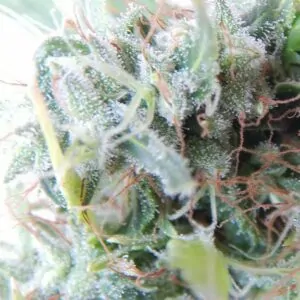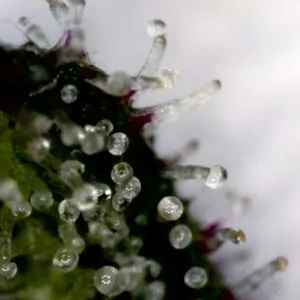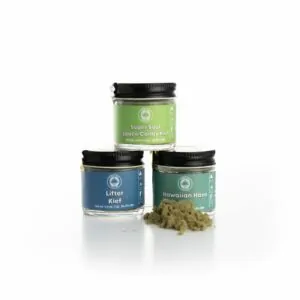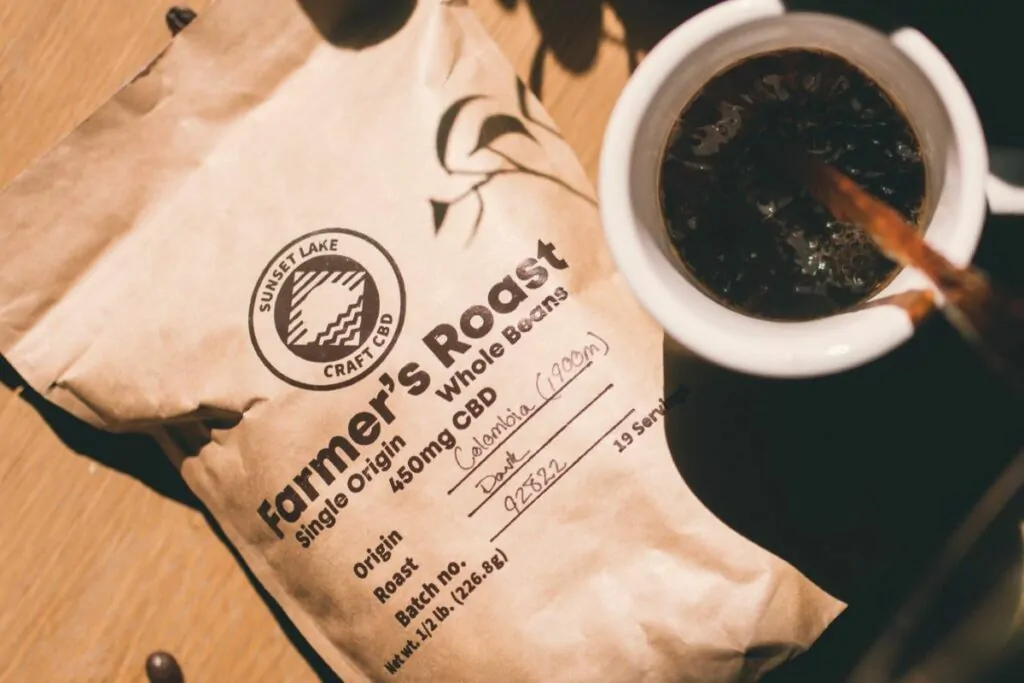No products in the cart.
What Is Kief: Everything You Need to Know
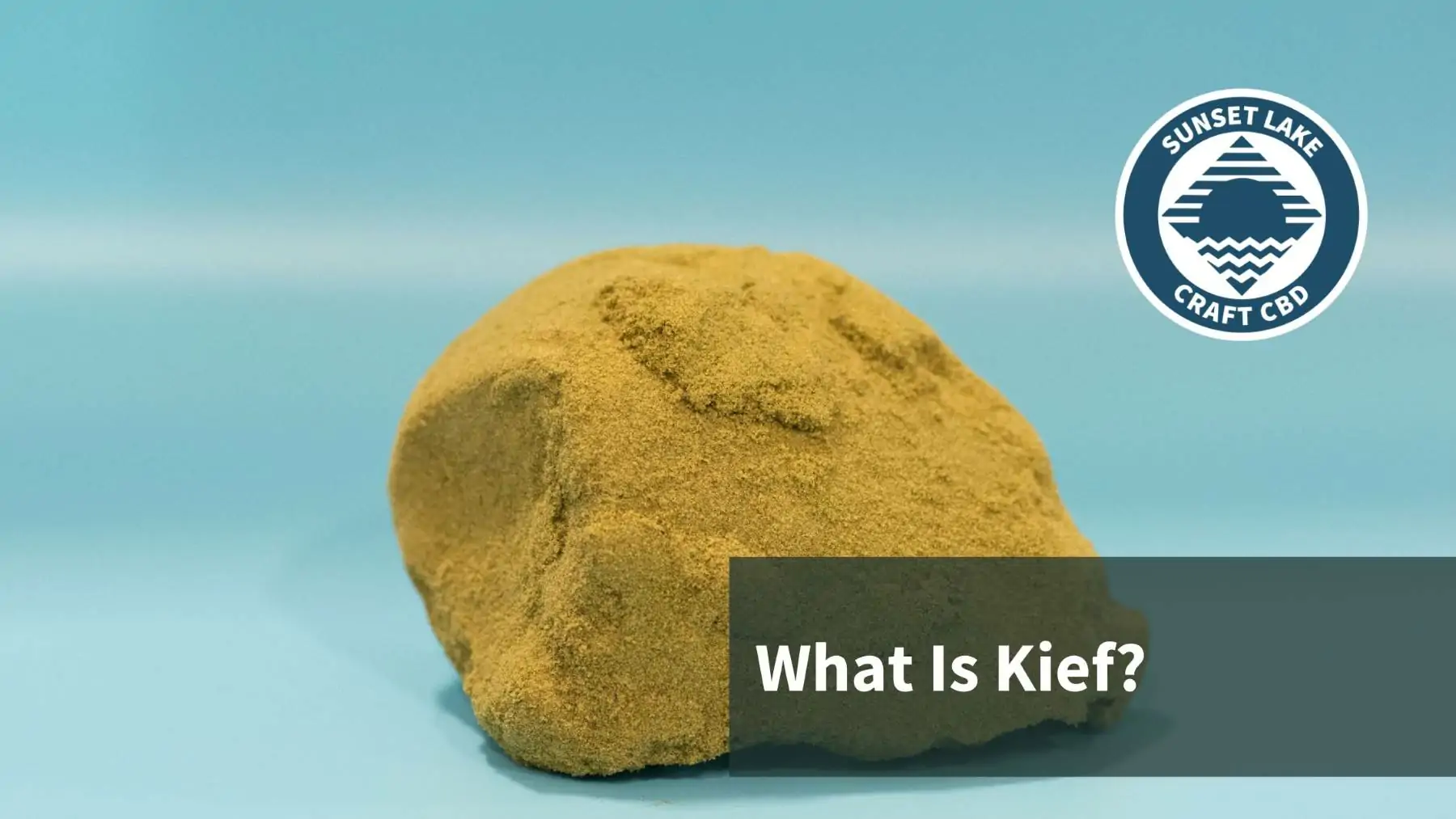
It’s yellow, sticky, and looks a little bit like the play sand we all used to have as kids. That’s right! This post is about kief, the solventless cannabis concentrate.
By the end of this article, you’ll know
- What kief is
- Where it comes from
- A little bit of its backstory
- And how you can use it to enhance your next smoking experience
What Is Kief?
If you’re like this author, you find hemp and cannabis flower visually striking. You look at it and admire the orange hairs, the color of the buds, and the small crystal formations all over the exterior. Individually, we call these mushroom-shaped formations “trichomes.”
Tons of plants produce trichomes, but they are quite special in hemp plants. In hemp and cannabis plants, trichomes create and store the flower’s cannabinoids, terpenes, and other phytochemicals. Essentially, trichomes are where we find all the desirable molecules.
Because of how hemp trichomes are shaped—long stalks with big bulbous heads—they break quite easily. We call a collection of broken trichome heads kief.
We measure kief’s potency the same way that we do dried hemp flower. First, we find the cannabinoid content in a sample and divide it by its weight. A normal CBD content for sungrown flower hovers around the low 20s. CBD Kief potency ranges anywhere from the mid-20s to mid-50s, meaning that on a weighted basis, it’s possible that half of the Kief’s weight could be pure CBD.
Where Does Kief Come From?
When we dry and process hemp flower, trichomes dry and break off from the flower more easily. Mature hemp plants produce three types of trichomes:
- Bulbous trichomes – 10 – 30 µm (micrometers.) The smallest of the three types. Bulbous trichomes are invisible to the naked eye but are the most numerous— covering the entirety of the plant.
- Capitate-Sessile – 25 – 100 µm. Capitate-sessile trichomes are larger than bulbous and take on the more familiar mushroom stalk-and-ball shape.
- Capitate-Stalked 50 – 500 µm. Capitate-stalked trichomes are so large that they are visible to the naked eye. These large trichomes tend to bulk up during the cannabis flower’s maturation. Because of their size, they can produce more cannabinoids and terpenes than either bulbous or -sessile trichomes.
More On Trichomes
Many plants, not just hemp, produce trichomes for different reasons. Some plants, like the carnivorous Cape Sundew, use their tentacle-like trichomes to capture and eat small insects.
Herbologists believe that hemp plants developed trichomes as a self-defense mechanism. Hemp trichomes, with their overwhelmingly bitter taste, deter hungry herbivores. The terpenes in the trichomes may also have antifungal properties, protecting the plant from molds and fungi.
Is It The Same As Hash?
Kief and hash (short for hashish) are not the same thing. To make hash, you need to apply pressure and heat to kief. The result in a solid mass of dark-brown to black-colored hash like the piece we see below.
When pressed, the cannabinoids and terpenes present in dry-sifted kief, oxidize into different phytochemicals altogether. For example, there’s a terpene called Hashishene that exists almost exclusively in hashish. Researchers believe that hashinene is a photolytic rearrangement of myrcene, a terpene commonly found in most hemp flower.
Where Did The Name Come From?
Kief gets its name from the Moroccan Arabic word كيف “kayf,” loosely translated to mean “opiate” or “joy.” It’s pronounced like “key-f” [keef].
There are a couple of ways to collect your own CBD kief from hemp flower. You will need some specialized equipment.
Four-Chambered Grinder
If you’re an experienced hemp flower consumer, you may already have or know what a grinder is. You’ll need a grinder with at least three chambers to catch kief. The bottom chamber, called the kief catcher, sits under a screen that catches ground flowers but is still large enough to allow trichome heads through.
When you grind your hemp flowers, trichomes will collect in the bottom chamber over time. It will take some time— weeks or months, depending on your consumption, but have no fear; it will happen.
Dry Sift With Screens
You can also collect CBD kief by agitating your hemp flower or hemp trim over a small-gauge silk screen.
Different-sized screens will yield different grades of kief. Finer screens will yield a higher-quality final product.
How To Store Your Kief
Regardless of your extraction method, you should store your CBD kief just as you store your bulk CBD hemp flower. To preserve your kief’s potency and flavor, keep it in a cool, dark, dry place. External pressures like excessive heat and UV light can ruin your kief and oxidize the cannabinoids inside.
Finding The Right Kief For You
If you want to skip all of the busy work of sifting your hemp flower, you can find and buy kief online. Sunset Lake CBD carries a few varieties in our store. Check out CBD Kief here.
Before you buy, there are a few things you’ll want to look for and do before you pull the trigger.
Figure Out What You Want Kief For
Just like picking an appropriate hemp flower for your needs, you’ll want to figure out what you want to use kief for. If your goal is to use CBD kief to get ready for bed, avoid kief from cultivars known for their energetic effects.
Look At The Certificate Of Analysis
We mention it on this site constantly. Before you purchase any CBD or hemp products online, be sure to look at the certificate of analysis.
Lab documents will list what cannabinoids, terpenes, and possible solvents are in your product.
Related: How To Read A Certificate Of Analysis (COA)
Look At Product Reviews
Aren’t sure about a specific product? Read some customer reviews!
Sometimes the only way to distinguish quality kief products from bad ones is to read about other’s experiences.
Using Kief To Enhance Your CBD Experience
Now that you’re an expert extractor and conscience consumer, how do you use kief? A great question, and one that we’ve written a non-exhaustive list for.
Smoke it
Mix your kief with hemp flower and spark it up. Many smokers who use pipes will tell you that a kief-topped bowl is the way to go, as it tends to stay lit longer and have a more noticeable flavor than a bowl without. If you add kief to your smokables, be sure to thoroughly mix it in; otherwise, you could end up with an uneven burn.
…Or Vape It
Vaping will not only bring out your kief’s full flavor, but it’ll be kinder to your lungs in the long run.
Be sure to clean your vape often if you decide to do this. Kief will gum up your vaporizer’s screens much quicker than hemp flower.
Make Moon Rocks
Moon rocks are small hemp buds covered in hash oil (another hemp concentrate) and then rolled in kief. They are potent, though not easy to make yourself. You would also need to have hash oil on hand.
Add To Your Coffee
Want to spice up your morning cup of coffee or tea? Add kief! This method requires a steaming hot drink, as the heat will decarboxylate (activate) the kief’s cannabinoids.
Coat Your Prerolls
If you have pre-rolled joints or some of Sunset Lake’s Kief Blunts, you can coat the outside of the wrap for an extra oomph. Get the wrap or paper a little wet and roll it in your kief.
Press Your Kief Into Hash
You can make your own homemade hash with a little heat and pressure. You’ll need some kief and parchment paper, a newspaper, and a clothes iron. Once you have everything, the steps are as follows.
- Place your kief inside the parchment paper and fold it until it’s flat.
- Roll this parchment paper into the fold of a newspaper and sprinkle a bit of water on the newspaper.
- Use an iron on a low setting and press it against the rolled-up newspaper.
- Turn the newspaper and press with the iron again until you’ve pressed each side of the newspaper for a few minutes.
- Unroll the newspaper and parchment paper when the newspaper is dried, and you’ll have a nice piece of hash.
Make Edibles
You can mix your kief with your hemp flower to make potent edibles.
Read our guest blog about baking with hemp and kief here.
Frequently Asked Questions
Is It Legal?
Kief’s legality depends on the state you live in and on whether or not it was harvested from CBD hemp flower or THC cannabis flower. CBD kief is federally legal, assuming it contains less than 0.3% delta-9 THC by dry weight.
THC kief is only legal in states where recreational THC cannabis flower is legal. Consult a local attorney for more specifics.
What’s The Point?
Kief is a cannabis concentrate that collects at the bottom of your grinder. You don’t have to use it, but it is a potent form of concentrate that takes almost no work to collect.
Does It Make You Sick?
Kief should not make you sick, provided that you use it as you would normal cannabis flower. If you’re allergic to hemp, cannabis, or pollen, you may have a slight reaction to kief.
Is It Dangerous?
As a hemp concentrate, kief contains a higher concentration of cannabinoids than your traditional cannabis flower, but as long as you consume it as you would hemp flower, you will be fine.
Updated:
July 2, 2024
Sources
- McGarvey, Casey. “Did You Know: There Are Different Types of Trichomes?” Delta Separations, 11 Nov. 2020, https://deltaseparations.com/types-of-cannabis-trichomes/.
- Brady, Pete. “Moroccan Hashish Journey.” Cannabis Culture, 21 May 2003, https://www.cannabisculture.com/content/2003/05/21/2860/
- Various, “The Readers Digest Gardeners Encyclopedia of Plants and Flowers”, Readers Digest Association, 1992
- Bennet Patrick. “What are Trichomes and why do they Exist on Cannabis?” Leafly, 28 July 2016, https://www.leafly.com/news/cannabis-101/what-are-trichomes-on-cannabis
- Livingston SJ, et al. Cannabis glandular trichomes alter morphology and metabolite content during flower maturation. The Plant Journal, Jan 2020;101(1):37-56.
- Small E, Naraine S. Size matters: evolution of large drug-secreting resin glands in elite pharmaceutical strains of Cannabis sativa (marijuana). Genetic Resources and Crop Evolution, Apr 2015;254(2).

